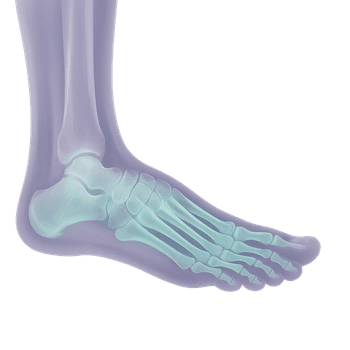Quick version
The foot is a central part of our musculoskeletal system and requires both strength and stability to function optimally.
- Consists of 26 bones and several joints
- Supports body weight and absorbs shock
- Common problems include heel spurs and flat feet
- Diagnosis is made with clinical examination and imaging
- The right shoes and exercise are important for foot health
What is the foot?
The foot is the lowest part of the leg that is in direct contact with the ground. It consists of 26 bones, over 30 joints, and a network of muscles, ligaments, and tendons. The foot is divided into three parts: the forefoot, the midfoot, and the hindfoot. Its main functions are to support the body's weight, absorb shock, and enable walking and running.
Anatomy and structure
The foot consists of 26 bones: 7 in the hindfoot (including the calcaneus and the talus), 5 metatarsals, and 14 toes. These are held together by ligaments and moved by both intrinsic and extrinsic foot muscles. Strong tendons such as the Achilles tendon (Achilles tendon) also play a central role in the foot's ability to move.
Function and biomechanics
The foot acts as a shock absorber and a lever when walking and running. Its arch structure makes it possible to handle body weight and dynamic load. The foot adapts to different surfaces and balances the body.
Movement and load
With each step, the foot undergoes a complex sequence of movements: heel strike, foot roll and push-off. This requires good muscle control, mobility and stability in the entire foot and ankle joint.
Development and age
In children, the arches of the feet are not fully developed and can be perceived as "flat". With age, the arches can sink, which can cause discomfort. Older people are more likely to suffer from wear and tear and poor circulation in their feet.
Common conditions and diseases
The foot is exposed to both acute injuries and overuse. Common problems include heel spurs, plantar fasciitis, hallux valgus, stress fractures and osteoarthritis. Incorrect shoes, being overweight and working a lot on your feet increase the risk of problems.
Examination and diagnosis
Diagnosis is often done through clinical examination, gait analysis and sometimes imaging diagnostics such as X-rays, ultrasound or MRI of the foot. A physiotherapist, orthopedist or podiatrist can make the assessment depending on the nature of the problem.
Relevant symptoms
- Pain in the heel, arch or forefoot
- Swelling or stiffness
- Numbness or tingling
- Toe or arch deviation
- Fatigue in the feet after activity
Related conditions and diagnoses
- Plantar fasciitis
- Heel spurs
- Morton's neuroma
- Hallux valgus
- Pes planus (flat feet)
- Arthritis of the ankle or toe joints
























